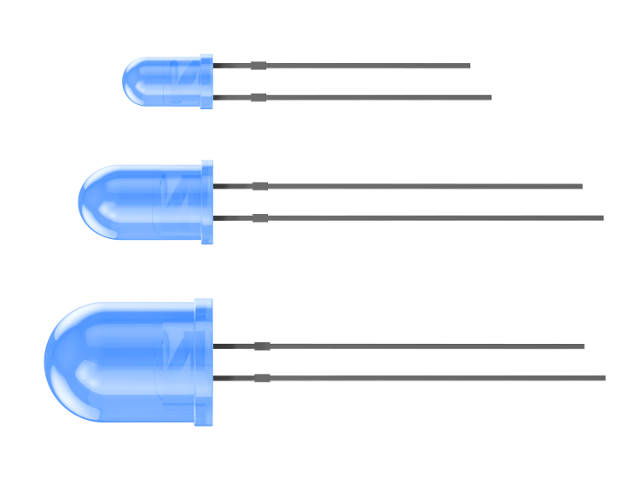
Image credit: Shutterstock
A new discovery explains the difficulty in making blue light-emitting diodes (LEDs). They used advanced computer simulations to reveal the properties of gallium nitride, which is the main component of blue LEDs.
The study was a collaboration between Researchers at University College London (UCL), the Daresbury Laboratory and the University of Bath.
The inventors of blue LEDs have been honored with the 2014 Nobel Prize in Physics. These LEDs have been used commercially for more than 20 years, and have contributed in endeavors to develop new types of energy saving lighting.
How do LEDS work?
Semiconducting materials are insulating materials that can be induced to conduct electricity under specific circumstances.
LEDs are made up of two layers of semiconducting materials - one of these layers has an excess of electrons, making it negatively charged, and the other has a deficit of electrons, forming electron holes, which makes it positively charged.
When a voltage is applied, electrons and holes meet at the junction between the layers, causing a photon to be emitted. The frequency of the light generated depends on the gap in energy between the positively and negatively charged (p-type and n-type) materials.
The 'doping' process is used to achieve the desired properties for each specific semiconductor layer. A crystalline film of a specific material is grown, and small quantities of an impurity are added to this material. The impurities donate either electrons or holes to the material.
Unexplained solution
The energy gap between the electrons and holes in gallium nitride is large - this is what allows the material to produce the higher-energy blue light that is out of the reach of other LED materials. Additional free electrons are relatively easy to generate through doping - however, large numbers of stable electron holes proved much more difficult to achieve.
A practical solution to this problem was devised by Isamu Akasaki, Hiroshi Amano and Shuji Nakamura, and won them the Nobel Prize for Physics in 2014. They found that enough holes could be generated by doping the material with unusually high levels of magnesium. This was a challenge for manufacturers, but not an insurmountable one, and commercial blue LEDs became available.
"While blue LEDs have now been manufactured for over a decade," says John Buckeridge (UCL Chemistry), lead author of the study, "there has always been a gap in our understanding of how they actually work, and this is where our study comes in.
"Naïvely, based on what is seen in other common semiconductors such as silicon, you would expect each magnesium atom added to the crystal to donate one hole. But in fact, to donate a single mobile hole in gallium nitride, at least a hundred atoms of magnesium have to be added. It's technically extremely difficult to manufacture gallium nitride crystals with so much magnesium in them, not to mention that it's been frustrating for scientists not to understand what the problem was."
Quantum modelling
This collaborative study utilized advanced computer simulations to explore, at the atomic level, the extraordinary behaviour of doped gallium nitride, to discover the root cause of the problem.
"To make an accurate simulation of a defect in a semiconductor such as an impurity, we need the accuracy you get from a quantum mechanical model," explains David Scanlon (UCL Chemistry), a co-author of the paper.
"Such models have been widely applied to the study of perfect crystals, where a small group of atoms form a repeating pattern. Introducing a defect that breaks the pattern presents a conundrum, which required the UK's largest supercomputer to solve. Indeed, calculations on very large numbers of atoms were therefore necessary but would be prohibitively expensive to treat the system on a purely quantum-mechanical level."
Hybrid quantum and molecular modeling played a pioneering role in 2013's Nobel Prize in Chemistry. In the current study, the researchers applied this approach and simulated various parts of the complicated chemical system with various levels of theory.
"The simulation tells us that when you add a magnesium atom, it replaces a gallium atom but does not donate the positive charge to the material, instead keeping it to itself," says Richard Catlow (UCL Chemistry), one of the study's co-authors.
"In fact, to provide enough energy to release the charge will require heating the material beyond its melting point. Even if it were released, it would knock an atom of nitrogen out of the crystal, and get trapped anyway in the resulting vacancy. Our simulation shows that the behaviour of the semiconductor is much more complex than previously imagined, and finally explains why we need so much magnesium to make blue LEDs successfully."
The sophisticated simulations answer many unexplained experimental results regarding gallium nitride’s behavior. Aron Walsh (Bath Chemistry) says "We are now looking forward to the investigations into heavily defective GaN, and alternative doping strategies to improve the efficiency of solid-state lighting".
The researchers have published their study in the Physical Review Letters journal.